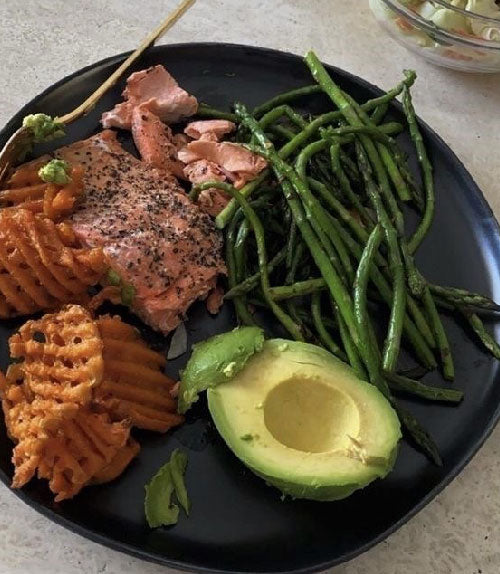Eating For Muscle Gain

At MWU we love to see how many of you are embarking on a Muscle Gain journey! 💪
As we’ve touched on in our Women's Guide to Building Muscle blog, building lean muscle is the ultimate way to shape and sculpt the physique you desire while also setting your body up for a long and mobile life!
Something we often get a lot of questions about is how to approach nutrition when aiming to build lean muscle. Now, the optimal environment for steady muscle gains is a slight calorie surplus - or eating more calories than you burn throughout the day, and this looks different for everyone.
The initial idea of extra calories can be very exciting - especially if you’ve been in a deficit for a long time! However, it can come with some potential challenges, such as:
- Feeling uncomfortably full
- Experiencing feelings of bloating or stomach distention, especially initially
- Not feeling hungry enough to finish all meals
- Being overwhelmed by having to distribute your targets between fewer meals (e.g. if you’re someone who only has time for 3 meals a day)
The secret to overcoming these challenges is finding the right balance between the volume of food and its nutrient and calorie density.
So, if you want to optimise your nutrition during a building phase - this blog is for you!
Let's talk High Calorie, Low Volume (HC-LV) Foods
Usually when you think of high calorie, low volume foods your mind jumps to your "soul foods", like donuts, pizza, ice cream, fries and alike!
These foods are all fine to consume in a healthy diet. However, relying on these options may put you at risk of developing nutrient deficiencies, as a building phase should ideally last for at least several months. Fear not - as you can certainly achieve a calorie surplus by consuming predominantly nutrient-dense, wholesome options (with occasional treats, of course - we’re all about that 80/20 approach 🍩🍞🍔).
Here are some great examples of Nutritious Foods that pack a punch in a relatively low volume:

Basing your meals around these and similar options will make hitting your daily nutritional targets much easier while helping to prevent the constant uncomfortable fullness!
Spreading out Meals & Macros
When eating in a calorie surplus, it is beneficial to spread out your meals strategically across the day. This prevents consuming very little in the morning and then having to eat a lot at night, and vice versa. Not only would doing this be challenging, it may also cut your nutritional targets short if you get to the evening and simply cannot consume what is left for the day. Imagine having a 2000 calorie target and only consuming 500 calories throughout the day - playing catch up later that night would be quite hard!
Distributing your meals also ensures not leaving a large amount of a particular macro to hit at the end of the day (looking at you, protein 👀). This approach has additional perks, too - for example, a steady supply of protein can be beneficial for stimulating muscle protein synthesis, supporting muscle growth!
Hitting your Targets Eating Fewer Meals
If you have a busy schedule, it can be extremely difficult to eat more than 3-4 meals a day. Not to worry - we’ve got you covered with our top tips:
- As outlined above, try and consume balanced calorie and macro meals throughout the day - this will prevent having to play catch up at night and also maximise your muscle protein synthesis. TIP: try using the Recipe Filter in the MWU App to find some larger meals to fill your requirements!
- Choose higher calorie, more nutrient dense ingredients to put into your meals
- Always keep energy dense snacks on hand to fill any gaps in your nutrition. For example - a high energy smoothie, homemade energy bliss balls, trail mix, or a protein bar.
- Consume a bedtime meal/snack/dessert
- If you’re really struggling to get your macros in, consider replacing your regular protein shake with a “gainer” - these are packed with carbs and sometimes fats in addition to protein, making reaching your goal more efficient. Remember though - we advocate for food first and supplements are NOT a replacement for a balanced diet!
- To increase the protein and fat content of your meals, you can add milk powder when cooking - this is great for mashed potatoes, creamy pasta, and casseroles! Only need to boost the protein? Pick a skim milk powder.
Example Meal Guide - 2200 calories, 113g P / 65g F / 291g C
Many of our MWU Meal Guides have been created with the above techniques in mind to help you reach your goals comfortably and enjoyably. For example, the Meal Guide below allows you to easily hit 2200 calories by including some more calorie and nutrient dense options, a good amount of whole foods, plus a little dessert for good measure 😉

We know that creating an optimal meal plan when you’re in a calorie surplus can be challenging, but we’re here to help! We hope this blog has helped break down some useful strategies and given you the confidence and tools for being more creative during your building phase.
To view more Meal Guides to help you on your muscle gain journey, sign up to become a Move With Us Platinum Member today. You will receive access to 15+ Programs and Levels, 1,500+ Recipes, Accountability Tracking and so much more!








